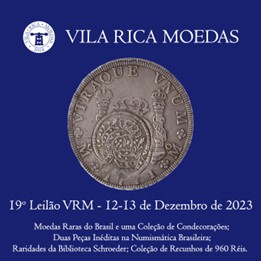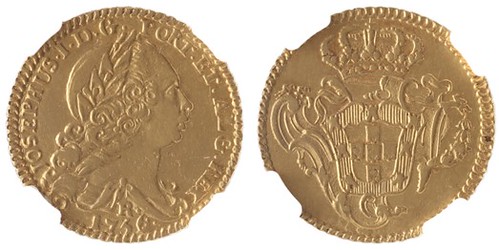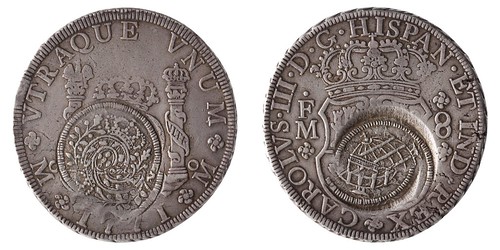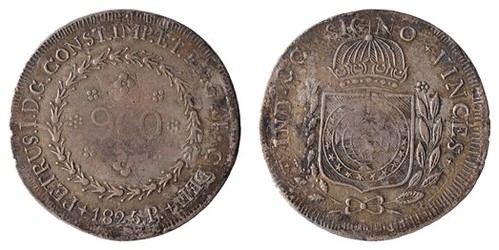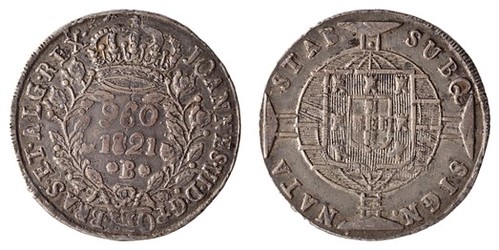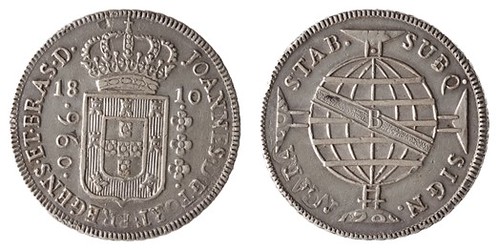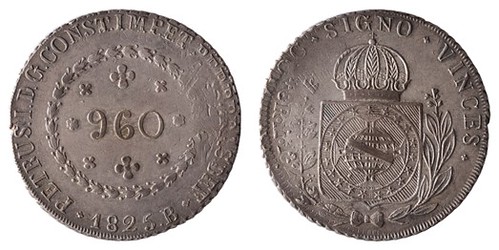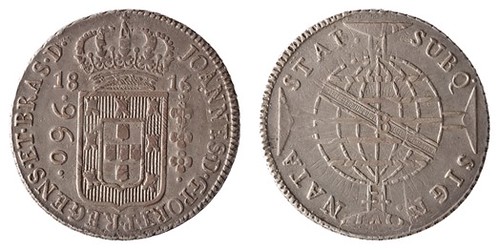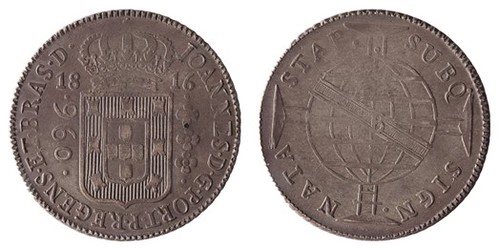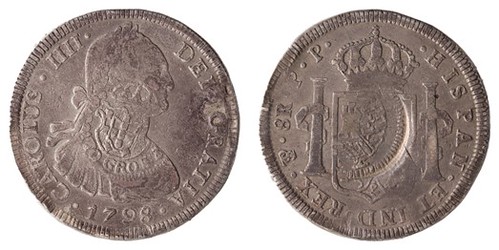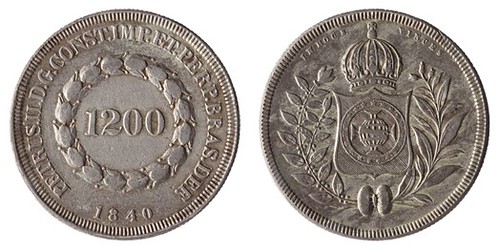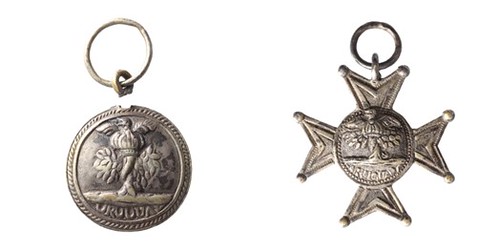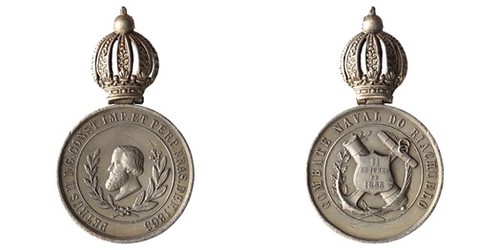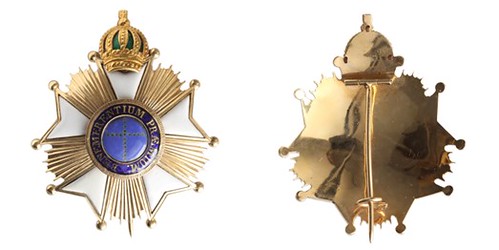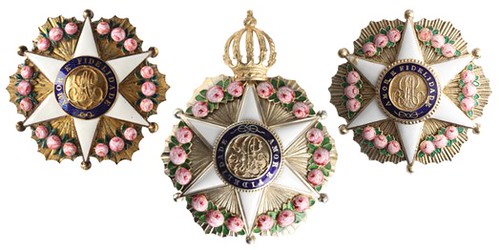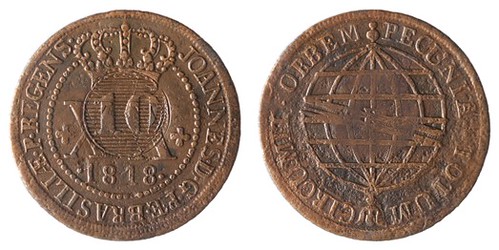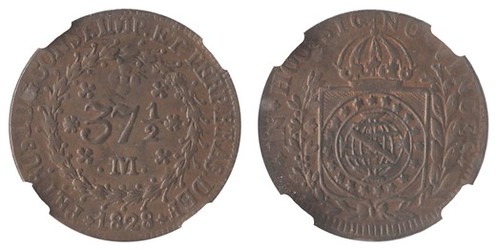
PREV ARTICLE
NEXT ARTICLE
FULL ISSUE
PREV FULL ISSUE
VILA RICA MOEDAS AUCTION 19Here's the announcement for the Vila Rica Moedas Auction 19,coming up December 12-13. For bibliophiles, there is a section of numismatic literature as described in the earlier article linked below. -Editor
Vila Rica will hold its Auction 19 on December 12th and 13th. The auction is internet-only and split over two sessions. It will offer a vast range of Brazilian coins and decorations from Colonial to Republican issues, featuring:
Some highlights of the sale follow: Lot 19 - Brazil, 3200 Réis, 1756/5R. Gold. AI O414. NGC XF Details (cleaned). Rare in any condition. Very few collections contain this 3200 Réis. Overdate 1756/5 clearly visible. Lot 21 - Brazil, 3200 Réis, 1780B. Gold. AI O475. PCGS AU details (Cleaned). Very rare, and even rarer in this condition. Very attractive with some original luster still present. The marks on the reverse are on the slab, not on the coin. Lot 78 - Brazil, 640 Réis, 1816M. Silver. AI P437; Lup 1A. Sob. Tiny nick at 8:00. Very rare and even rarer in this condition. Stronger and deeper strike than the average for this coin, resulting in a complete and perfect impression of the shield, escutcheons denomination and date, and on the reverse of the armillary sphere and showing a complete and perfect mint letter "M", thus making this one of the best existing examples of this elusive Minas Gerais issue. Legends almost complete and on top of it all a beautiful patina.
Lot 83 - Brazil, Foundry House of Vila Rica, ND (circa 1808-1810). Die for gold ingot applied to 8 Reales
silver coin. On the obverse, Foundry stamp with shield crowned between branches, below "V.R."; on the
reverse armillary sphere on cross. On the beak of the sphere semicircular detail characteristic of this reverse
stamp. The stamp, documented on 8 gold ingots between 1810 and 1812, is the Oval V.R. It was applied
twice, with the 1st application at 45° and the 2nd application at 270° in relation to the vertical axis of the
host. The second strike is weaker, with about 30% of the punch applied, and obliterating the 1st strike. The
host is an 8 Reales from Mexico, 1771FM Carlos III, columnar type (
Produced at some point in the period between the end of 1808 and the end of 1810, possibly as a Minas
Counterstamp test using a gold bar stamp (there is also the possibility that it was produced in 1811-12 (while
the V.R. Oval Stamp was still active). The comparative analysis of the stamps on the bars and on the coin
leaves no doubt as to their authenticity on the pillar dollar (this piece). It is, therefore, a piece of the highest
rarity and produced at one of the most interesting moments of the Brazilian numismatic history. For a more
in-depth study, see
https://www.vilaricamoedas.com/media/textos/artigos/ Lot 84 - Brazil, 960 Réis, 1825P. Silver. Levy – Unpublished; AI - Unpublished; Bentes 494.01. VF. 26.1g; 42.5mm. Coinage from the Province of Grão Pará. Extremely rare, with no more than a dozen reported examples. This one, struck over 8 Hispano-American Reales, is not included in the Gomes & Bertapeli catalog (2018). According to the authors, the 960 Réis coins (as well as the 80 Réis coins) with the letter "P" were issued on an emergency basis in the Province of Grão Pará. This province was in a state of total economic hardship after Brazil's independence for being the last province to align itself with the Empire and at the same time for no longer receiving support from Portugal. The creation of a provincial currency (emergency and unofficial) served as a temporary solution to prevent circulating currency from leaving the province. Lot 85 - Brazil, 960 Réis, 1821B. Silver. AI P463a; S&R 6C; BC 1. aEF. Over-overstrike of 960 Réis 1821B over 1820B. Date of the base 960 clearly visible under the date 1821. Coin reported in the Hélio Guimarães catalog supplement (1985) as the only one known (var 22). Since then, at least two others have been identified. Still, an extremely rare and interesting coin. The coin provokes interesting thoughts - if the Bahia Mint continued to mint coins in 1817, 1818 etc. with a date of 1816, why then mind "re-dating" a 960 Réis from 1820 to 1821? Lot 88 - Brazil, 960 Réis, 1810B. Silver. Levy 1.54; AI P395; S&R 6C; BC 18. EF. Over 8 Reales Mexico 1792FM Carolus IIII. Struck OBVERSE ON REVERSE - extremely rare on Bahia Mint coins, with only a few examples reported on some dates. According to Margraf (SNP Bulletin #95, 2023) in 1810B there are 3 reported specimens. Full visibility. Ex. Ildemar Margraf Collection. Lot 93 - Brazil, 960 Réis, 1825B. Silver. Levy 11.66; AI P510; S&R 2A; BC 2 (E). EF. Over 8 Reales Mexican Republic 1824JM "Hookneck". While Mexican Republic 1823JM overstrikes are relatively common on Imperial coins, those with host dated 1824 are extremely rare. Beautiful coin, in an exceptional condition for the date, and with a very attractive patina. Lot 101 - Brazil, 960 Réis, 1824B. Silver. Levy 10.131; AI P509; S&R 10C; BC 8. AU. Over 8 Reales Potosi 1819PJ Ferdin VII. Despite having been lightly cleaned, it presents itself in an exceptional state of preservation, even more for being 1824B. Interesting variety with a "shadow" of "960" displaced and below the denomination. The die sinker cut the denomination off-center, filled the cavity and reopened the digits in the correct place. Some remains are still visible around the actual denomination. Lot 105 - Brazil, 960 Réis, 1816B. Silver. Levy 7,136; AI P401a; S&R 12B; BC 32. EF. Over 8 Reales Argentina (Potosi) 1813J. ARGENTINE SUN, on the reverse. Total visibility and rare in Bahia. Exceptional effect of the Sun on the reverse, under the armillary sphere. A spectacular overstrike. Ex. Ildemar Margraf Collection; ex. José S. da Silveira, Ex. Solano de Barros (no envelope). Reference: SNP Bulletin #52; Margraf (2009), page 64, plate coin; Margraf (2021) page 232. Lot 108 - Brazil, 960 Réis, 1816B. Silver. Levy D.10; AI P401a; S&R 2A; BC 8. EF+. Struck on a virgin planchet (no overstrike). Extremely rare. According to Margraf (2009), there is only one piece reported. The piece offered here is not the same as the one illustrated in the reference and is therefore a second example. Beautiful patina and some remaining original luster. Lot 116 - Brasil, 960 Réis, Carimbo Mato Grosso, SD (1818). Silver. AI P483. MBC. 26.35g; 42.5mm. One of the rarities of Brazilian numismatics - Counterstamp MATO GROSSO (in full) on 8 Reales Potosi 1798PP Carolus IIII (rare as a host than 8 Reales of Ferdin VII). Although the coin has signs of having been removed from jewelry, this fact in no way detracts from the beauty of this coin - large disc, full edges, with a beautiful patina. A practically complete stamp - MATO GROSS - only the final "O" is not visible, which makes this coin even more desirable, as it is more common for there to be much less letters visible. Lot 122 - Brazil, 1200 Réis, 1840/37. Silver. AI P556. VF+. Overdate 1840 over 37. Very rare - only 633 pieces struck. Lot 322 - Portugal, Decoration, 19th century. Silver. Military Order of the Tower and Sword. Knight/Dame Medal. 20.2g; 10cm (with ribbon). Small missing green enamel on the reverse but other than that, a perfect and wonderful piece. Rare as such. Lot 323 - Portugal, Decoration, 19th century. Badge with the Orders of Christ, Avis and Sant'iago da Espada - Insignia of Grand Cross or Dignitary. Gold, silver vermeil and enamel. Obverse with an oval medallion carved and hollowed out by a floral composition centralizing a flower with four petals, bearing oval shaped badges decorated with their respective enamels on white backgrounds and borders in their respective colors, with that of the Order of Christ above and, below, that of the Order of Avis on your left and the Order of the Tower and Sword on your right. Reverse with hollow and smooth metal finish, vertical closure and pin. 54g; 66x51mm. Piece alike to that belonging to the Guilherme Guinle Collection, sold at auction by the Soraia Cals Art Office (lot 131) on 11/21/2018. The Band of the Three Orders brings together, in a single insignia, the Grand Crosses of the Ancient Military Orders of Christ, Avis and Sant'Iago da Espada, the ancient Portuguese monastic-military orders founded in the Middle Ages. According to the official website of the Presidency of Portugal (https://www.ordens.presidencia.pt/), this unique decoration appears to have its origins in the fact that Pope Julius III granted in perpetuum, to the Portuguese Crown, the Grand Master of the three ancient Monastic-Military Orders, by the bull Praeclara Clarissimi, of November 30, 1551. The creation of the Band of the Three Orders took place in the Reform of the Orders of D. Maria I, on June 17, 1789. The sovereign decreed that the monarch must use the insignia of the three military orders simultaneously, so as not to give precedence to any of them. In this way, the Banda das Três Orders became the most important Portuguese decoration. Lots 325 and 326 - Brazil, Military Decoration, 1822. Cisplatine Campaigns. General campaigns 1811-1812 and 1816. Silver. 4.85g (with ring); 22mm, circular medal, uniface, showing an olive tree encircled by a dragon (symbol of the House of Bragança) surmounted by a royal crown and on the banks of the Uruguay River, with the word URUGUAY below. Loose tape holder. Created according to decree of 09/25/1822. Extremely rare. No record of sales in the last 20 years. According to Fernando Chao (Premios y Condecoraciones em Territorio Uruguayo 1807-1830, Rosário, 2020) it is an extremely rare piece, with only two pieces cited among all the collections and auctions consulted: the illustrated (drawn) example in Marques dos Santos (Brazilian Military Medals, 1937) and another example in the collection of the Eugênio Teixeira Leal Museum / Memorial do Banco Econômico de Salvador. Brazil, Military Decoration, 1822. Cisplatine Campaigns. General campaigns 1811-1812, 1816 and 1822. Silver. 6.4g; 22mm, Maltese cross medal with knobbed ends, uniface, showing in the center an olive tree encircled by a dragon (symbol of the House of Bragança) surmounted by a royal crown and on the banks of the Uruguay River, with the word URUGUAY below. Created according to decree of 09/25/1822. Extremely rare. No record of sales in the last 20 years. According to Fernando Chao (Premios y Condecoraciones em Territorio Uruguayo 1807-1830, Rosário, 2020) it is an extremely rare piece, with only a few pieces mentioned among all the collections and auctions consulted: two copies sold in ""Catalog de Monedas y Medallas en Venta en la Casa Pardo"", from 1928 (lots 1785 and 1786) and another sold by Jacques Schulman on 11/24/1970, lot 426 (which is the same example plate Meili 8). After almost 10 years of conflict and disorder, the region we now know as Uruguay was devastated. The circumstances were such that the population was willing to accept any solution that brought some peace. It was under these conditions that the new province was annexed to the United Kingdom of Portugal, Brazil and Algarves by Treaty of July 31, 1821, sanctioned by a Congress convened by General Carlos Frederico Lécor. The annexed province is referred to by the Portuguese as ""Província Cisplatina"". Prince Regent D. Pedro decided to create a medal to distinguish all those who had fought in Uruguay under the orders of General Lécor since 1816. The decree of September 25, 1822, officially proposes the reuse of the design of the 1813 decoration (1811-1812 campaign). For those who had fought in 1811-1812 and 1816, the medal would be the same round one (only worn on the chest with a ribbon, instead of attached to the arm) and, for those who had also fought in the 1821 campaign, the medal would be in the center of a Maltese cross, hanging on the chest by a ribbon. Lot 329 - Brazil, Military Decoration, 1865. Meili 125; VC 97. EF. Riachuelo Naval Combat. Rare! Established in 1865. 17.5g; 43x26mm. Silver. Obverse: Pedro II on the left, surrounded by a wreath of tobacco and coffee leaves, legend "PETRUS II DG CONST. IMP. ET PERP. BRAS. DEF. 1865. On the reverse "COMBATE NAVAL DO RIACHUELO" involving a trophy consisting of a cannon and an anchor resting on a wreath of palm trees and laurels, in the center a shield with the date "JUNE 11, 1865", topped by an articulated imperial crown, from the Brazilian Mint. Commemorating the largest and most important naval battle of the Latin American history on June 11, 1865. Very rare in silver, and even rarer with the crown hinge intact. Lot 331 - Brazil, Decoration, 19th Century. Imperial Order of the Cross - Insignia of Commander or Grand Officer. Gold and enamel. On the obverse, a star in white enamel with five double points, knobbed and lying on a splendor, with a medallion on a sky-blue background with stars aligned in a Latin cross, surrounded by a blue iron border with the legend "BENEMERENTIUM PRAEMIUM", surmounted by imperial crown. Reverse with smooth metal finish, vertical closure, and pin. 29.3g; 61x53mm. Piece identical to that in the Guilherme Guinle Collection (Lot 9, Soraia Cals Art Office, 11/21/2018). An absolutely delightful piece. Lots 332, 333 and 334 - Brazil, Decoration, 19th Century. Order of the Rose - Commander's Insignia. Silver vermeil and enamel. Obverse with a six-pointed white enamel star set on a garland of roses, lying in a glow, with a medallion in the center surrounded by a blue border with the legend "LOVE AND FIDELITY" surrounding the intertwined initials "P" and "A". Reverse with smooth finish, vertical closure and pin. Respectively 52.2g; 62mm / 33.8g; 53x71mm / 12.47g; 37m. After the death of Dona Maria Leopoldina in 1826, Emperor Dom Pedro I married in 1828 Dona Amélia de Leuchtenberg and Eischstädtin 1828 in a second marriage and, to immortalize this celebration, he created the Imperial Order of the Rose on February 27, 1829. This order would be intended to reward military and civilian personalities, Brazilians and non-Brazilians, recognized for their valuable performance in the State and unshakable loyalty to the emperor. According to Meyer, P. and Bibiani, R. in the description of similar lots from the Guilherme Guinle Collection (Catalogue of the Auction Office of Art Soraia Cals, November 2018), the designs of the insignia, erroneously and often attributed to Jean-Baptiste Debret, were in fact made from originals signed by Eugène de la Michellerie and Pierre-Joseph Pezerat and would have found inspiration in the delicate embroidered roses on a certain dress of the empress Lot 373 - Brazil, Essay, 1970s. Titanium. AI - Unpublished (RRR). UNC. Titanium is an extremely hard metal, and at the same time light. This combination of properties led CMB (Casa da Moeda do Brasil - Brazil's Mint) to assess this material for minting Cruzeiro coins, even though there was no significant production of this metal in Brazil. Due to the various attempts to control inflation in the 1960s and 1970s, the adoption of new monetary standards with Cruzeiro Novo in 1967 and Cruzeiro in 1970 opened the possibility of adopting more durable metals for minting coins, which, due to the desired monetary stability, would circulate for longer. Thus, the CMB conducted coinage tests with titanium, with a view to eventually adopting this metal in the coinage of 1 Cruzeiro coins, manufactured from 1967 onwards. With a design very similar to the coinage tokens of the presses used at the time, with the arches of the Palace da Alvorada in Brasília, and with the representation of the gates of the Casa da Moeda in Praça da República, this essay presents the same module as the 1 Cruzeiro coins from 1967 (29 millimeters). The weight of the piece, a key characteristic for its identification, is 5.75g. Typical porosity should also be highlighted. The shallow minting depth, seen in the low detail of the lions' heads that flank the gate and in the details of the gate, can be attributed to the hardness of the titanium and the eventual low coining pressure adopted.
Much more than any technical issues, the adoption of this metal for coinage would be abandoned due to the
acceleration of inflation and the consequent reduction in the expected circulation life for these coins.
Additionally, the rise of stainless steel as a coining metal (a trend that would last in the CMB until the end of
the 1990s) would definitively put an end to this project. Titanium was never used again by CMB since then.
Extremely rare essay, with only two known examples, one in a private collection in São Paulo and the other
being precisely this piece. To see the full article, visit
https://www.vilaricamoedas.com/media/textos/artigos/ Lot 443 - Brazil, XX Réis, 1818R. Copper. AI C472 (without stamp). EF+. For Goiás and Mato Grosso. With general stamp (Carimbo Geral) of 10 Réis. Very rare and possibly unique (previously unknown with c/s). Lot 479 - Brazil, 37 1/2 Réis, 1828M. Copper. AI C730. NGC AU55 BN. Final year of the series. Very well struck and very attractive. 2nd highest grade in NGC. Very rare in this condition. The auction will take place on December 12th and 13th. Registration for bidding can be done at https://leiloes.vilaricamoedas.com/. If you need assistance, please feel free to contact either David or Hilton through the email info@vilaricamoedas.com and they will be happy to assist you with registration. Bids can also be accepted through the Sixbid platform.
To read the earlier E-Sylum article, see:
Wayne Homren, Editor The Numismatic Bibliomania Society is a non-profit organization promoting numismatic literature. See our web site at coinbooks.org. To submit items for publication in The E-Sylum, write to the Editor at this address: whomren@gmail.com To subscribe go to: https://my.binhost.com/lists/listinfo/esylum All Rights Reserved. NBS Home Page Contact the NBS webmaster 
|
